
Commodore is a badge name surrounded in mystery as there is very little to go on. Some have stated that these guitars are the
product of Bunny Milne - a sheetmetal worker by trade that used his skills
to manufacture steel guitars from 1945 to sometime in 1966, trading as 'Milton Products' which were distributed throughout New Zeland
by Western Enterprises.
Like many instrument makers of the time, The advent of rock'n roll gave Milne the incentive to design and manufacture a different kind of guitar - this time a solid
body instrument like the one shown above left and right. As can be seen on this guitar, and many instruments prior - Bunny chose 'Commodore' as his brand name for
many of his instruments.
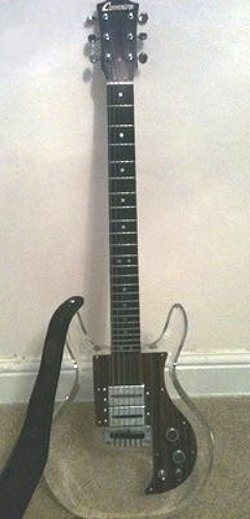
|
However, Bunny Milne had retired prior to the MIJ-Golden Era of guitar making - doing a small, local business out of his basement in his retirement.
By the time Dan Armstrong and Ampeg had released Dan's new creations to the world, the Commodore brand name was likely all but forgotten, save for the
Bunny Milne fans around the world that love and cherish his instruments, and his legacy to this day. There is even a Bunny Milne page on Facebook.
With the increase of guitar production throughout the 1960s and 1970s in Japan the Commodore name had surfaced once again. This time
with a copy instrument, styled after a 1969 Gibson ES-335 with a red - yellow sunburst finish.
Eventually other guitars were produced - all styled after models of various American guitar manufacturers up to, and including the
Dan Armstrong · Ampeg guitar copy seen at left.
|
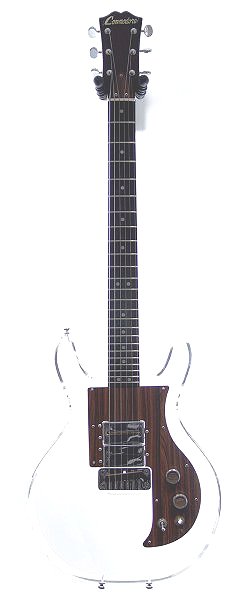
|
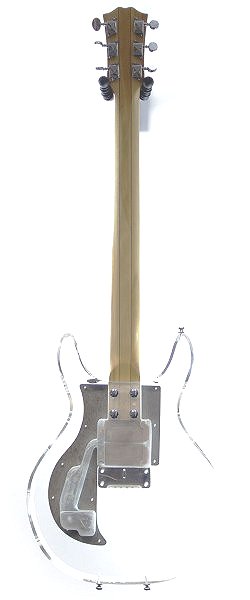
|
As seen above left & right these instruments are virtually (if not totally) identical - both in looks and features to the Aria and the Univox Lucy models.
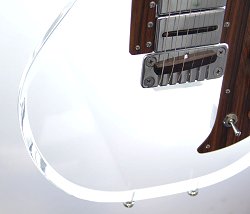
|
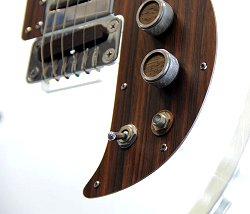
|
At left, and exactly like the Aria model - what appears to be an actual Danelectro bridge saddlepiece. Also identical are the
single coil trapezoid pickups. At right, notice the same volume & tone knobs, scratchplate, and 3-way selector switch. Here too is a washer underneath
the output jack. Seen better in the enlarged view, notice too, how the screws securing the scratchplate to the acrylic body do not seat flush with the
surface of the scratchplate. Most likely whoever installed the washer under the output jack did not get the scratchplate secured down adequately.
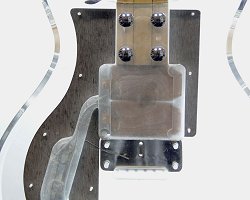
|
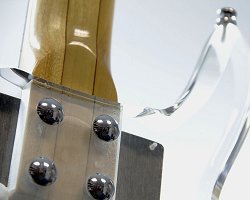
|
At upper left, the routing of the acrylic body for the pickups and control cavity. However, unlike the Aria model there is no separate channel
routed for the ground wire. Here the ground wire actually leaves the routing channel and travels over to ground the tailpiece. As a result it's
not quite as cleanly done as the Aria model, but very little of it can be seen from the front.
At upper right, and again just like the Aria model, the three piece laminated maple neck can be seen. Equally like the Aria, the neck seats into
the body and rests against the front pickup. But it must also suffer the stability issues of the Aria.
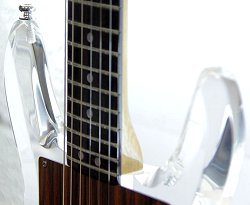
|
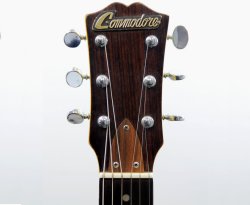
|
At upper left, and not surprising, the exact same larger dot position markers as the Aria model - while at right, the same shape headstock,
headstock veneer, tuners, and truss rod cover as well. The only thing on the entire instrument that differs from the Aria model is the
'Commodore' name-plate. Seen better in enlarged view, it is 'tacked' into place.
According to the old Guru's Guitar Guide, "Commodore was a UK importer brand name, that at first produced various 'cheapo' originals, then some copies, eg Dan Armstrong
see through solid repro."
Guitarist, guitar author, journalist and collector Paul Day thought these instruments originated from Matsumoku and were imported/badged by Rosetti. Others
have stated that Commodore instruments were imported/badged by Rosetti as well - and they could be correct. However, the Rosetti advertizement from the approximate
time frame - which can be seen in the Brochures section of this site - shows many badged names under their proverbial 'tent' - but Commodore is not among any of those
listed, so it's all still very elusive and seems destined to remain that way.
copies menu
main menu
Names and images are TMand © Dan Armstrong / Ampeg. All rights reserved.
All other names and images are TMand © of their respective owners. All rights reserved.
|
| |

